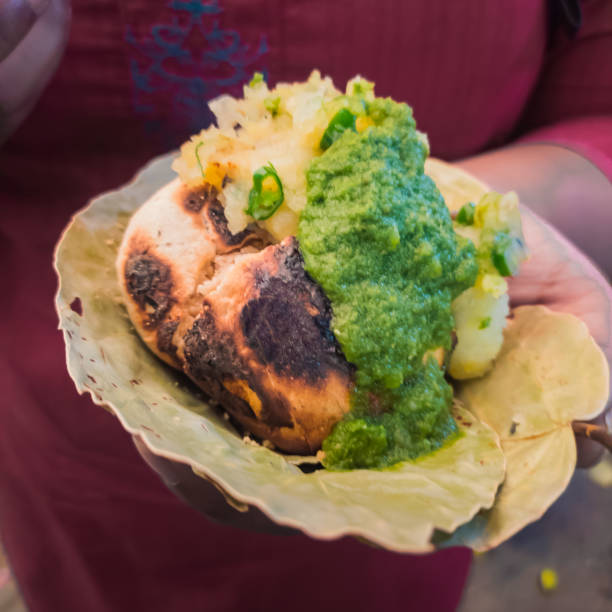When it comes to traditional Indian cuisine, Litti Chokha and Baati Chokha often cause confusion. Both dishes feature dough balls baked or roasted, served with smoky mashed vegetables, and originate from North India. So, are they the same dish with two names, or are they actually different?
The answer: they are closely related but not identical. While they share some similarities, Litti and Baati differ in ingredients, preparation, and cultural roots.
In this post, we’ll explore the key differences and similarities between Litti Chokha (Bihar) and Baati Chokha (UP/Rajasthan) to help you truly understand what makes each unique.
🧭 Origin and Cultural Background

🫓 Litti Chokha
- Region: Bihar, parts of Jharkhand and Eastern Uttar Pradesh
- Cultural Significance: A staple of Bihari households and street food culture. Associated with rural simplicity and rich in regional pride.
- Typical Pairing: Served with Chokha – a mashed mix of roasted eggplant (baingan), boiled potatoes (aloo), and/or tomatoes (tamatar).
🫓 Baati Chokha
- Region: Predominantly eastern Uttar Pradesh (Varanasi, Ghazipur, Ballia, etc.), and often confused with Rajasthani Baati, which is different.
- Cultural Significance: Popular street food and homestyle meal in Purvanchal (Eastern UP).
- Typical Pairing: Served with Chokha, similar to Litti, but with slight differences in spice and oil use.
💡 Note: Baati is also a famous dish in Rajasthan, but in that context, it is usually served with dal (lentils) and not Chokha.
🧾 Ingredients – What Goes Inside Matters
🍥 Litti – Stuffed With Sattu
- Dough: Whole wheat flour mixed with salt, ajwain (carom seeds), and water.
- Filling: Sattu (roasted gram flour) mixed with mustard oil, garlic, green chilies, lemon juice, onions, and sometimes dry mango powder or spices.
- Binding agent: Mustard oil – adds sharpness and authenticity.
- Flavor profile: Spicy, tangy, earthy – thanks to raw mustard oil and garlic.
🍥 Baati – Usually Plain (Sometimes Stuffed)
- Dough: Made with whole wheat flour, ghee, salt, and a bit of baking soda or yogurt (optional).
- Filling: Typically no filling in the traditional version (though modern twists may include mashed peas, potatoes, or paneer).
- Binding agent: Ghee – adds richness and smoothness.
- Flavor profile: Mild, buttery, and simple – meant to be dunked in chokha or dal.
🎯 Key Difference:
Litti is always stuffed, Baati is usually plain or lightly spiced.
🔥 Cooking Techniques
🍽️ Litti: Roasted or Baked
- Traditionally cooked over cow dung cakes or charcoal fire.
- Modern versions are oven-baked or roasted on a tandoor or tawa.
- After cooking, Littis are dipped in or brushed with hot desi ghee for softness and flavor.
🍽️ Baati: Baked or Fried
- Traditionally baked in a clay oven (mitti ka chulha) or over open flames.
- Sometimes deep-fried, especially in street-food versions.
- Always dunked in melted ghee after cooking.
💡 Pro Tip: Baati is generally more golden and crusty. Litti is more roasted and smoky.
🥔 Chokha – The Common Link
Chokha is where the two dishes overlap, but even here there are regional touches.
🔥 Litti Chokha Chutney
- Uses raw mustard oil liberally.
- More garlic-heavy.
- Slightly spicier with stronger flavors.
🔥 Baati Chokha Chutney
- Uses less mustard oil (sometimes vegetable oil).
- Milder in spice.
- Tomato chokha is more prominent in some UP versions.
Both types of Chokha include:
- Roasted or boiled vegetables (eggplant, tomato, potato)
- Chopped onion, green chilies
- Garlic, mustard oil, salt, coriander leaves
✅ Tip: In Bihar, Baingan Chokha is most common. In UP, Tamatar Chokha often dominates.
🧈 Ghee – The Final Touch
Both Litti and Baati are incomplete without a generous drizzle or dip in desi ghee. However:
- Baati is heavier on ghee and often soaked in it before serving.
- Litti is lightly brushed or dipped after roasting.
🧂 Litti is meant to be rustic and health-conscious. Baati leans more toward indulgence.
🥣 Serving Styles and Accompaniments
| Element | Litti Chokha | Baati Chokha |
|---|---|---|
| Stuffing | Sattu (spiced) | Usually plain (sometimes stuffed) |
| Chokha type | Aloo, Baingan, Tamatar | Aloo, Tamatar (less Baingan) |
| Oil used | Raw mustard oil | Mustard oil or other cooking oil |
| Ghee use | Brushed after cooking | Soaked/dunked in ghee |
| Cooking method | Roasted, tandoor, or baked | Baked or sometimes deep-fried |
| Texture | Smoky, slightly soft | Crusty, more dense |
| Regional origin | Bihar | Eastern Uttar Pradesh |
| Taste profile | Spicy, garlicky, sharp | Milder, rich in ghee |
🔄 Litti vs Baati vs Rajasthani Dal Baati
To clarify even more:
- Litti Chokha (Bihar): Sattu-stuffed dough balls + mashed vegetables (chokha).
- Baati Chokha (UP): Plain or mildly stuffed dough balls + chokha (especially tomato-based).
- Dal Baati (Rajasthan): Plain dough balls + spicy dal + churma (sweet crumble).
These are three distinct dishes even though the dough ball base looks similar.
📝 Conclusion: Similar Soul, Different Identity
At first glance, Litti Chokha and Baati Chokha may seem like regional names for the same food — and while they do share a lot in common, each has its own identity, flavor profile, and cultural depth.
If you love bold, spicy, mustard-oil-rich flavors, Litti Chokha from Bihar will win your heart. If you prefer a more mellow, buttery version, Baati Chokha from UP is your go-to.
Both dishes are a celebration of India’s rich culinary diversity — and both are absolutely worth trying.